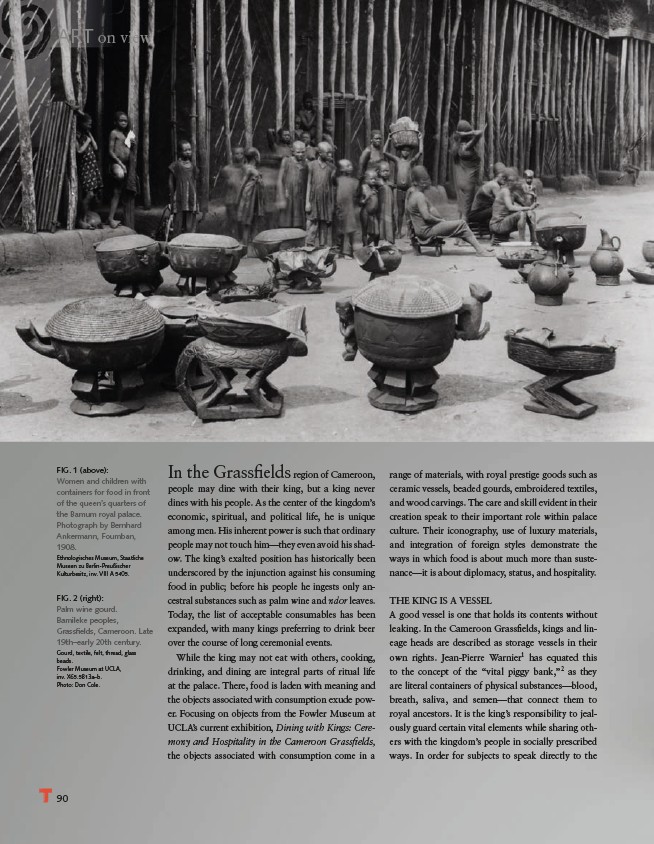
FIG. 1 (above):
Women and children with
containers for food in front
of the queen’s quarters of
the Bamum royal palace.
Photograph by Bernhard
Ankermann, Foumban,
1908.
Ethnologisches Museum, Staatliche
Museen zu Berlin-Preußischer
Kulturbesitz, inv. VIII A 5405.
FIG. 2 (right):
Palm wine gourd.
Bamileke peoples,
Grassfi elds, Cameroon. Late
19th–early 20th century.
Gourd, textile, felt, thread, glass
beads.
Fowler Museum at UCLA,
inv. X65.5813a–b.
Photo: Don Cole.
90
In the Grassfi elds region of Cameroon,
people may dine with their king, but a king never
dines with his people. As the center of the kingdom’s
economic, spiritual, and political life, he is unique
among men. His inherent power is such that ordinary
people may not touch him—they even avoid his shadow.
The king’s exalted position has historically been
underscored by the injunction against his consuming
food in public; before his people he ingests only ancestral
substances such as palm wine and ndor leaves.
Today, the list of acceptable consumables has been
expanded, with many kings preferring to drink beer
over the course of long ceremonial events.
While the king may not eat with others, cooking,
drinking, and dining are integral parts of ritual life
at the palace. There, food is laden with meaning and
the objects associated with consumption exude power.
Focusing on objects from the Fowler Museum at
UCLA’s current exhibition, Dining with Kings: Ceremony
and Hospitality in the Cameroon Grassfi elds,
the objects associated with consumption come in a
range of materials, with royal prestige goods such as
ceramic vessels, beaded gourds, embroidered textiles,
and wood carvings. The care and skill evident in their
creation speak to their important role within palace
culture. Their iconography, use of luxury materials,
and integration of foreign styles demonstrate the
ways in which food is about much more than sustenance—
it is about diplomacy, status, and hospitality.
THE KING IS A VESSEL
A good vessel is one that holds its contents without
leaking. In the Cameroon Grassfi elds, kings and lineage
heads are described as storage vessels in their
own rights. Jean-Pierre Warnier1 has equated this
to the concept of the “vital piggy bank,”2 as they
are literal containers of physical substances—blood,
breath, saliva, and semen—that connect them to
royal ancestors. It is the king’s responsibility to jealously
guard certain vital elements while sharing others
with the kingdom’s people in socially prescribed
ways. In order for subjects to speak directly to the
ART on view